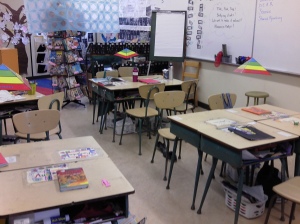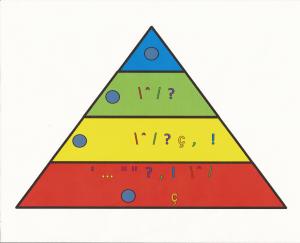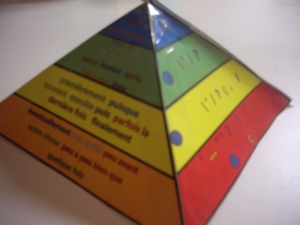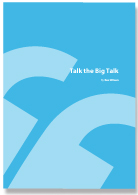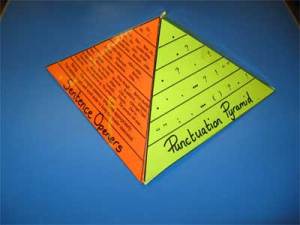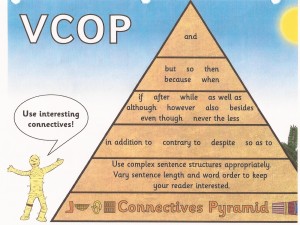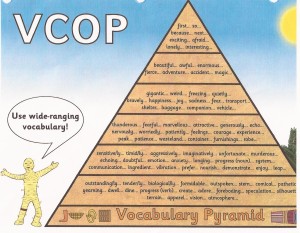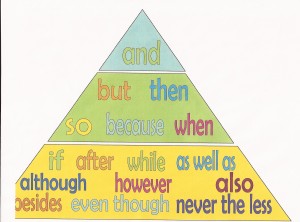Another way to use the pyramids. They are always handy and take no desk space.
My Teacher Librarian shared this wordless picture book with me-I can’t wait to try it out! Thanks L.H.!! Chalk by Bill Thomson
I love wordless picture books. There is so much you can do with them. When my daughter was three years old , she could sit for hours pouring through the pictures making up her own stories. The adventures changed slightly every time but she was loving books and thinking about words . She was enriching the story by noticing new details and drawing new conclusions about the story. She knew stories had a beginning middle and an end. She then started “writing” out her stories in a notebook. And yes- she still loves to read and write!
I was thinking about her the other day when I was encouraging a group of teachers to improve their student writing. They looked at me like I had two heads, they were just not able to see “any purpose” for these books without words.
Here are my Top Ten Reasons to use wordless picture books:
1. allow everyone to feel successful
2. lead to discussion ,critical thinking and creative writing
3. improve reading and writing skills
4. sequence of events and retelling strategies
5. helping children develop the basic building blocks of language
6. encourage the introduction of new vocabulary openers, connectors, signal words
7. develop story telling skills at any age
8. allows for individual and cultural interpretations
9. learn about clues in the pictures by paying attention to details
10. great for synthesizing and other comprehension strategies like making connections, determining important inferring and
Not mine but important…
Cassady, J.K. (1998). Wordless books: No-risk tools for inclusive middle-grade classrooms. Journal of Adolescent and Adult Literacy, 41, 428–432.
- David Wiesner (author of Tuesday) identifies one of the most valuable characteristics of wordless books-the endless possibilities for creative interpretations.
- Wordless books enhance creativity, vocabulary, and language development for readers of all ages, at all stages of cognitive development, and in all content areas.
- The creativity stimulated by wordless books encourages older students to look more closely at story details, to carefully consider all story elements, and to more clearly understand how text is organized so that a story develops.
A great link to take a look at:
http://www.famlit.org/pdf/talking-about-wordless-picture-books.pdf
My book arrived from Andrell education last night. I have already started reading it. I am excited to give this a try!!!
SO excited to find this blog on Big Writing . My books arrived from Andrell Education yesterday too, so I am set to learn more
Miss Toffee’s Class has all sorts of amazing ideas- Check out her blog 🙂
http://misstoffeesclass.blogspot.com/2011/09/its-been-while-here-is-my-class.html
These sections of a Big Writing pyramid would be cut out, assembled and shared one per table group. After a great deal of conversation about the writing , students would self assess using the pyramids. I would like to give credit to the designer. I just don’t know who did!!!
I am really excited to give this a try. The VCOP above are for older students. The ones below for younger students. I am missing the vocabulary section. Working on the French Translation.
Connectors
So we asked ourselves-would Big Writing work in French Immersion???
We think it would for sure!!!
|
ECRIRE GROS (adapted by Sylvie Pauze and Lezlie Goudie-Cloutier July 2011 from Big Writing by Ros Wilson) |
|
|
Les quatre buts généraux |
|
|
VCDP |
Sommaire |
| Vocabulaire | L’étendue du vocabulaire ambitieux connu par l’élève (mots dynamiques) |
| Connecteurs | L’étendue des structures déjà acquises par l’élève pour connecter idées, segments de phrases et phrases. |
| Démarreurs | Les stratégies déjà acquises par l’ élève pour démarrer les phrases: surtout les démarreurs clé: connecteurs, mots se terminant par ment et ant(inf. pres) |
| Ponctuation | L’étendue de la ponctuation déjà acquise par l’élève. |
My discovery of the summer…Not sure what to think of it yet. I need to do some more research and try it out …
Big Writing
If a Child Can Say It,
A Child Can Write It
Big Writing is teaching method or strategy developed by UK based Ros Wilson in order to raise writing standards with children aged 5-11. It is the development of the “writing voice” largely though oral activities. The aim of Big Writing is to advise schools on how to raise a child’s attainment level in speaking, listening and writing.
The premise for BIG WRITING is: If a Child Can Say It,A Child Can Write It .Some people say if the kids can’t say it the kids can’t write it-either way- We need to teach them how to say it , so that they can write it.
Ros believes that there are four points that are key to improving anyone’s writing: vocabulary, connectives, openers and punctuation which she shortened to V.C.O.P.
|
The Four Generic Targets of Big Writing |
|
|
VCOP |
Summary |
|
Vocabulary |
The range of ambitious vocabulary a pupil knows ( WOW words) |
| The range of ways pupils have of joining ideas ,phrases and sentences | |
|
Openers |
The strategies pupils have for opening sentences: especially the key openers: connectives, ly words and ingwords |
| The range of punctuation a pupil can use and the accuracy with which they use it. | |
Big Writing is being implemented in the UK and around the world. I learned about it from my sister-in-law who teaches with International schools.
I was given the following Description of Big Writing:
- part one Big Writing developed ( Criterion Scale) From October 1999 Ros spent three years working with the Kirklees LEA re-assessing work other teachers had already graded. She read through and marked around 20,000 pieces of writing and began to notice a trend , observing that some teachers struggled to properly assess work, /often with too high of an opinion of their pupils’ work. She noticed the students who were under achieving, and especially the ones that teachers had given too high a grade, were failing for the same reasons. Problems appeared to be common. Ros decided to develop a standard which could be used by teachers to more accurately assess their pupils. It was from this Ros created the Criterion Scale, which takes a more scientific approach to assessing writing. Using this Ros believes teachers can more accurately critique a students work, and therefore better able to help their students.
- An additional facet of big writing is that the pupils are taught to speak during Big Writing session and at certain other times during a week. The idea behind this is that if a child learns to speak properly, it will lead to fewer errors in spelling and grammar. These Big Writing sessions are advised to be consistently held during a chosen period, with the recommended being 1.5 hours across morning break plus daily ‘stocking fillers’ (5 minutes at the end of other lessons). Through Big Writing pupils are encouraged to be ambitious, to see where they need to improve their work and pay attention to their use of V.C.O.P., the toolkit for writing at a higher level. Stealing and borrowing are also encouraged when pupils see elements of V.C.O.P. in peers’ work that they like.
‘Big Writing’ – Wiki
‘Big Writing’ is a strategy for raising standards in writing developed by Ros Wilson, that has been implemented in thousands of primary schools throughout the United Kingdom and around the world. The method relates to the English language only.
Ros Wilson developed her Criterion Scale to standardise the assessment of over twenty thousand pieces of children’s writing between October 1999 and October 2002. As an associated project setting short-term targets for children, it became evident that there were ‘Four Generic Targets’ for writing, Vocabulary, Connectives, Openers and Punctuation or V.C.O.P.. This was true regardless of the age or level of writing skill. Further work and assessment led to the realisation that the Four Generic Targets that ‘grow’ as the pupil’s writing skill grows.
Wilson was able to refine her method during a period working in Qatar, whilst helping to establish an English speaking school near the city of Doha. All of the staff were trained to employ her method for teaching writing across the school and the results were remarkable. Upon her return to the U.K., she published her first book with Kirklees LEA and subsequent titles documenting the method with Andrell Education Ltd.
‘Big Writing’ is the development of the ‘writing voice’ through fast, fun, lively and predominantly oral activities. Pupils talk the ‘writing voice’, which becomes known as ‘Posh Talk’ in a dedicated ‘Big Writing’ session & at other points in a week. Schools introducing ‘Big Writing’ are advised to make it special, designating a session of one and a half hours per week split across morning break, with daily ‘stocking fillers’ (5 minutes at the end of other lessons).
‘Big Writing’ is based on the premises:Creating a positive ethos for writing is crucial.If a child can’t say it, they can’t write it!. ‘Big Writing’ and its associated strategies stress the importance of talk and that ‘boys love to talk and what is good for the boys is good for the girls!’.Sharing the secret garden of assessment with pupils, and explaining exactly targeted assessment and measuring of progress, empowers and excites them.Most pupils can succeed as writers far beyond levels usually expected for their age when taught the skills of writing scientifically. If pupils do not use their writing skills regularly they will lose them.
As Ros Wilson said:
Ask yourself;
“Do all the children in your class feel excited and empowered about writing?”
Remember;
You make the difference! Keep it lively, engaging and exciting for those pupils in your classes!
Creating a positive environment for writing will help to embed learning, to raise the status of writing as an activity in the classroom and to motivate pupils. Changing the environment by:
- Introducing soft, classical music
- Dimming or changing the lighting, possibly introducing a lava lamp
- Creating displays celebrating successes and targets
- Making water freely available for writing sessions
- Ensuring that examples of work, guidelines, any written work is of good quality and clear. The care that you take and example set give a sub-conscious message about the importance of writing.
Through ‘Big Writing’ pupils are encouraged to be ambitious, to up-level their work and pay attention to their use of V.C.O.P., which with The Punctuation Pyramid, becomes a toolkit for writing at a higher level. Stealing and borrowing are encouraged when pupils see elements of V.C.O.P. in peers’ work that they like. The concept is simple, that children do not need to understand the educationalist terminology to use the skills in their work.

